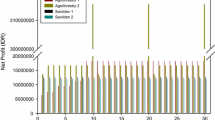Abstract
This research contrasts the financial profitability of different agroforestry practices in community-based buffer zone management of Madhupur National Park (MNP), Bangladesh. This park is the second largest in Bangladesh and subjected to enormous anthropogenic pressure and land rights-related conflicts. This paper reports the different agroforestry practices of villagers in different modules of the buffer zone of MNP, identified by a participatory research approach. It then assesses the profitability of each module on the basis of cost–benefit analysis, net present value, internal rate of return, and annualized income. Results indicate three agroforestry systems were being practised in the buffer zone by the participants: agro-silviculture, agro-silvo-horticulture, and combined woodlot and agroforestry. Among these modules, agro-silvo-horticulture was the most profitable, followed by agro-silviculture then combined woodlot and agroforestry. We recognize that not all of the participants can practise intensive agroforestry; our results suggest that the community-based buffer zone management strategy for MNP would benefit from prioritizing agroforestry practices where possible. This will lead to more successful buffer zone management for the conservation of natural forests while supporting the development of local resource-dependent communities.




Similar content being viewed by others
References
Ajayi OC, Akinnifesi FK, Sileshi G, Kanjipite W (2009) Labour inputs and financial profitability of conventional and agroforestry-based soil fertility management practices in Zambia. Agrekon 48:276–292
Alam M, Furukawa Y, Harada K (2010) Agroforestry as a sustainable land use option in degraded tropical forests: a study from Bangladesh. Environ Dev Sustain 12:147–158
Ashley R, Russell D, Swallow B (2006) The policy terrain in protected area landscapes: challenges for agroforestry in integrated landscape conservation. Biodivers Conserv 15:663–689
Bisong FE, Andrew-Essien EE, Animashaun AI, Utang PB (2009) Indigenous agroforestry initiatives for protected area management: a study of ‘support zone’ villages of the Cross River National Park, Nigeria. Eur J Sci Res 25:165–173
Elevitch CR, Wilkinson KM (2000) Economics of farm forestry: financial evaluation for landowners. Agroforestry guides for pacific island #7, Sustainable Education Research and Education
Farooque M (1997) Law and custom on forest of Bangladesh: issues and remedies. Bangladesh Environmental Lawyers Association, Dhaka
Folke C (2004) Traditional knowledge in social–ecological systems. Ecol Soc 9(3):7
Franzel S, Denning GL, Lillesø JPB, Mercado Jr AR (2004) Scaling up the impact of agroforestry: lessons from three sites in Africa and Asia. Agrofor Syst 61:329–344
Garrity DP (2004) Agroforestry and the achievement of the millennium development goals. Agrofor Syst 61:5–17
Heinen JT, Mehta JN (2000) Emerging issues in legal and procedural aspects in buffer zone management with case studies from Nepal. J Environ Dev 9:45–67
Hoque AE, Nazrul-Islam AKM, Huq SMI (2008) Seasonal variability of edaphic features of Madhupur sal forest of Bangladesh. Ecoprint 15:7–14
Khaleque Q, Gold MA (1993) Pineapple agroforestry: an indigenous system among the Garo community of Bangladesh. Soc Nat Resour Int J 6:71–78
Kumar BM (2006) Agroforestry: the new old paradigm for Asian food security. J Trop Agric 44:1–14
Lai CK (1991) Design of agroforestry systems: some examples and lessons from Bangladesh. For Ecol Manag 45:193–198
Lynagh FM, Urich PB (2002) A critical review of buffer zone theory and practice: a Philippine case study. Soc Nat Resour 15:129–145
Manandhar PK (1986) Plan of action of agroforestry programme in Community Forestry Project in 1986 (RR). ADB/FAO Project BDG/81/028, Bogra
Martin CE, Chehebar C (2001) The national parks of Argentinian Patagonia—management policies for conservation, public use, rural settlements, and indigenous communities. J R Soc N Z 5:845–864
Mehta JN, Heinen JT (2001) Does community-based conservation shape favorable attitudes among locals? An empirical study from Nepal. Environ Manag 28:165–177
Michon G, Mary F, Bompard J (1986) Multistoried agroforestry garden system in West Sumatra, Indonesia. Agrofor Syst 4:315–338
Muhammed N, Koike M, Sajjaduzzaman M, Sophanarith K (2005) Reckoning social forestry in Bangladesh: policy and plan versus implementation. Forestry 78:373–383
Muhammed N, Koikea M, Haquea F, Miah MD (2008) Quantitative assessment of people-oriented forestry in Bangladesh: a case study in the Tangail forest division. J Environ Manag 88:83–92
Murniati GDP, Gintings AN (2001) The contribution of Agroforestry systems to reducing farmers’ dependence on the resources of adjacent national parks: a case study from Sumatra, Indonesia. Agrofor Syst 52:171–184
Priess JA, Mimler M, Klein AM, Schwarze S, Tscharntkr T, Steffan-Dewenter I (2007) Linking deforestation scenario to pollination services and economic return in coffee agroforestry systems. Ecol Appl 17:407–417
Rahman MM, Vacik H, Begum F, Nishad A, Islam KK (2007) Comparison of structural diversity of tree-crop associations in peripheral and buffer zones of Gachabari sal forest area, Bangladesh. J For Res 18:23–26
Rahman MM, Motiur MR, Guogang Z, Islam KS (2010) A review of the present threats to tropical moist deciduous Sal (Shorea robusta) forest ecosystem of central Bangladesh. Trop Conserv Sci 3:90–102
Rashid M, Satter F (2006) Indigenous people’s land right: Bangladesh perspective. Presented in international conference on land, poverty, social justice and development. Institute of Social Studies, The Hague
Salam MA, Noguchi T, Koike M (2005) Factors influencing the sustained participation of farmers in participatory forestry: a case study in central Sal forests in Bangladesh. J Environ Manag 74:43–51
Stræde S, Treue T (2006) Beyond buffer zone protection: a comparative study of park and buffer zone products’ importance to villagers living inside Royal Chitwan National Park and to villagers living in its buffer zone. J Environ Manag 78:251–267
Author information
Authors and Affiliations
Corresponding author
About this article
Cite this article
Tuihedur Rahman, H.M., Deb, J.C., Hickey, G.M. et al. Contrasting the financial efficiency of agroforestry practices in buffer zone management of Madhupur National Park, Bangladesh. J For Res 19, 12–21 (2014). https://doi.org/10.1007/s10310-013-0392-3
Received:
Accepted:
Published:
Issue Date:
DOI: https://doi.org/10.1007/s10310-013-0392-3




